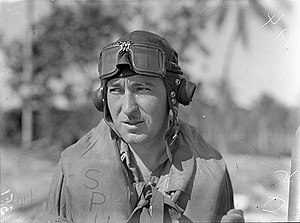Robert Spurdle | |
|---|---|
 Robert Spurdle, as a flight lieutenant in 1943 with No. 16 Squadron in Espiritu Santo | |
| Nickname(s) | Peter, Spud[1] |
| Born | 3 March 1918 Wanganui, New Zealand |
| Died | 5 March 1994 (aged 76) Whitianga, New Zealand |
| Allegiance | New Zealand |
| Service | Royal New Zealand Air Force (1939–1940; 1945–1946) Royal Air Force (1940–1945) |
| Rank | Wing Commander |
| Commands | No. 80 Squadron |
| Battles / wars | |
| Awards | Distinguished Flying Cross & Bar Mention in despatches |
Robert Lawrence "Peter" Spurdle DFC & Bar (3 March 1918 – 5 March 1994) was a New Zealand flying ace of the Royal Air Force (RAF) during the Second World War. He was credited with the destruction of ten enemy aircraft.
Born in Wanganui, New Zealand, Spurdle joined the Royal New Zealand Air Force (RNZAF) in 1939. After completing flight training in 1940 he was sent to the United Kingdom and transferred to the RAF. He flew Supermarine Spitfires with No. 74 Squadron during the later stages of the Battle of Britain and later flew with No. 91 Squadron. From late 1942 and into the following year, he was temporarily attached to the RNZAF, firstly in a training capacity in New Zealand, and then in the Solomon Islands campaign with No. 16 Squadron. He returned to Europe in 1944, flying with No. 80 Squadron as its commander. After the end of the war in Europe, Spurdle returned to service with the RNZAF and was discharged in 1946. In civilian life he worked as an engineer before taking up yachting. He died in 1994 at the age of 76.